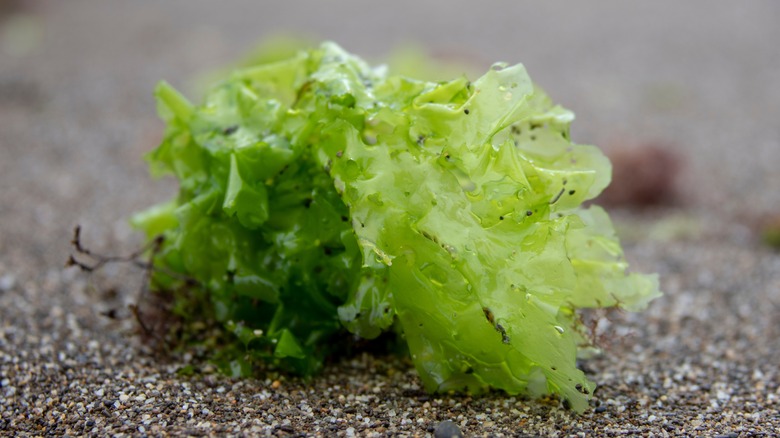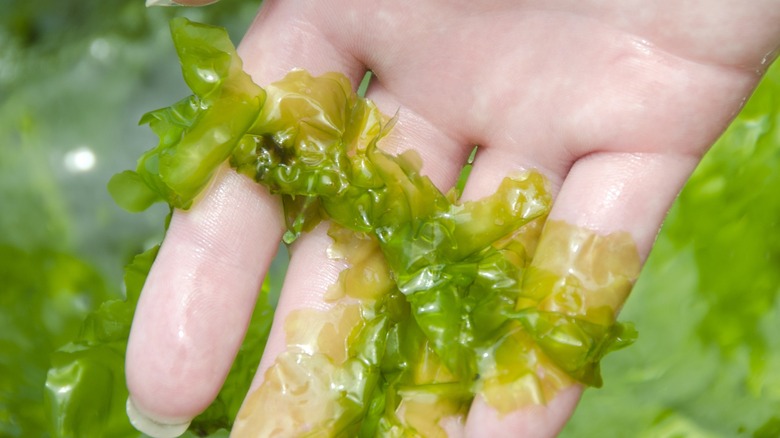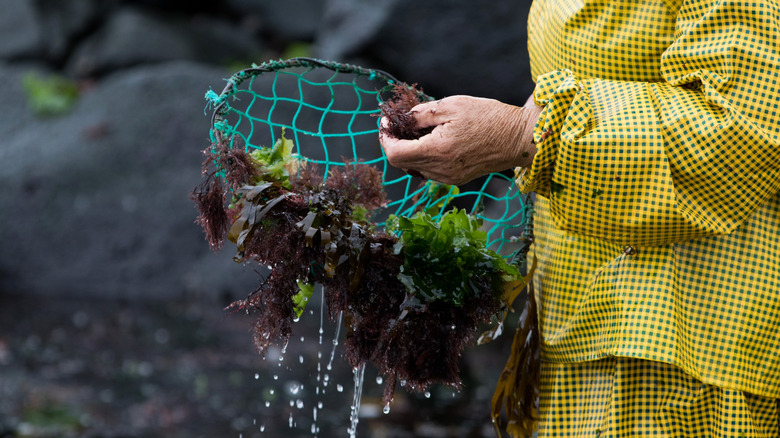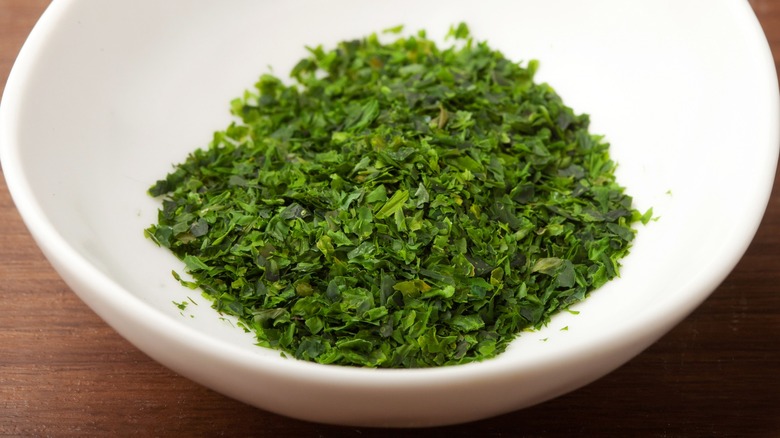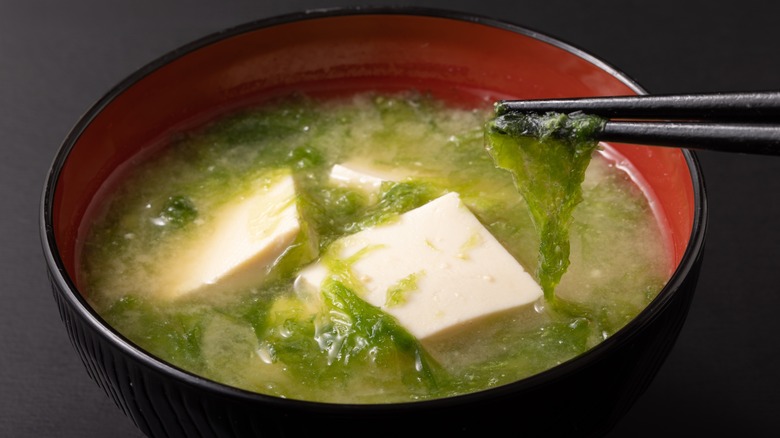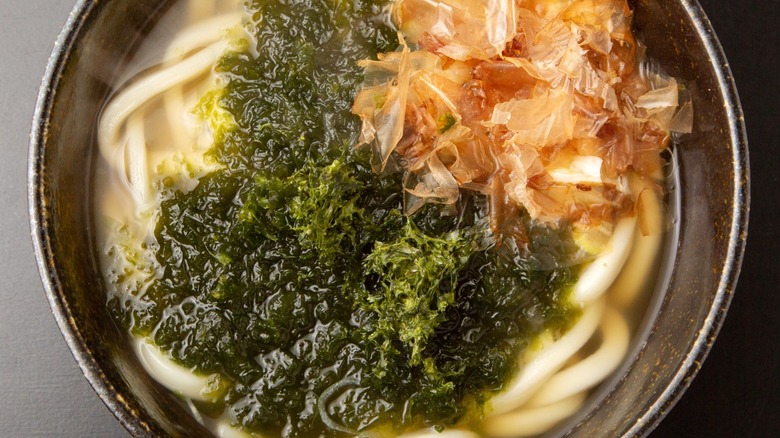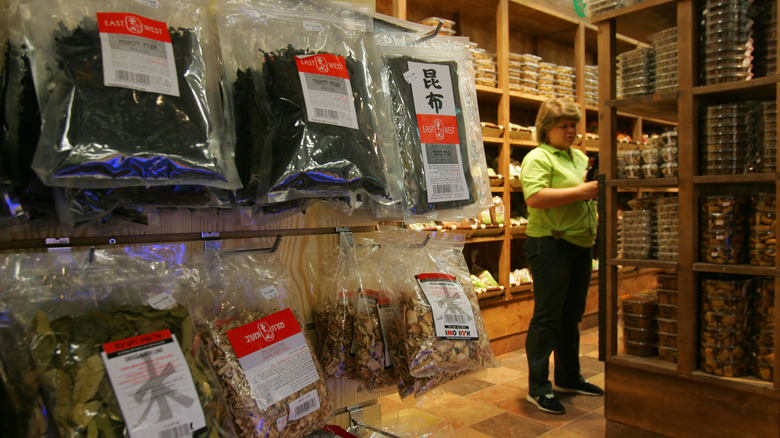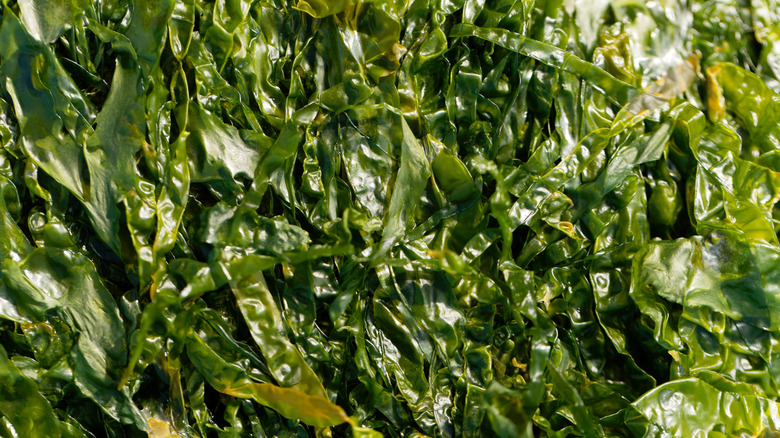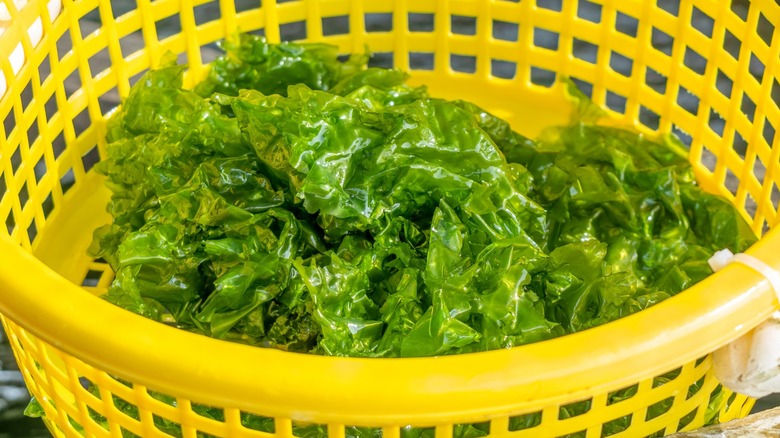Sea Lettuce Is The Bright Ocean Leafy Green With A Peppery Taste
When most people talk about eating their greens, they're referring to dark leafy vegetables like kale, spinach, bok choy, Swiss chard, and arugula — all of which are grown on land. But there's a whole world of other green veggies out there, and you'll find them in our oceans. Referred to by the United Nations as blue foods, the vegetables that grow down in the deep blue sea come in an assortment of colors — from red to brown, and, as mentioned before, green.
Among them are ocean-bred alternatives to your pickles, green beans in the form of sea beans, kombucha in the form of kombu-cha, and even your lettuce. Sea lettuce (Ulva lactuca) is just one of the many ocean vegetables that have been enjoyed by Indigenous coastal communities around the world for generations — namely in Okinawa, Japan, a Blue Zone that is home to some of the longest-living people in the world. But the connection between Blue Zones and blue foods like sea lettuce is by no means a coincidence.
Unlike the lettuce that grows on land, sea lettuce is superpowered by the same benefits the ocean grants other edible seaweeds, including omega-3s, zinc, iron, and vitamins A, D, and B12, along with a surprising peppery and umami flavor. What's perhaps the most impressive thing about sea lettuce, along with other blue foods, is that experts consider it a crucial component of repairing the global food system. As we face climate change and a future with even more people to feed, sea lettuce takes the term "superfood" literally.
What is sea lettuce?
Scientifically known as Ulva lactuca, sea lettuce belongs to Ulvaceae, a family of flat green algae. While it's most commonly known as sea lettuce, communities in Asia also refer to it as aosa or aonori. It's thought to be one of the most useful sea vegetables, as it is not only consumed as food, but is used in aspects of agriculture, pharmacology, and medicine, too. While the largest blooms occur in the summertime, sea lettuce grows all year round — and all over the world. From North and South America to southwest Asia, and from Africa to New Zealand, sea lettuce doesn't just grow in nearly every ocean in the world but at every level of the intertidal zone.
As its name suggests, this tasty seaweed does look a lot like lettuce. Lobed, with ruffled edges, sea lettuce ranges in color from bright green to deep emerald green to almost yellow — though its color changes after it's been dried. Without a stem, sea lettuce grows directly from its holdfast that attaches to rocks and shells. However, it can also be found free floating. While it can grow to anywhere from 40 to 50 centimeters in length, sea lettuce isn't considered large. In fact, sea lettuce blades are only one to two cells thick; in turn, they appear translucent and are often found with tattered edges and holes. It's only their bright color and sheer abundance that makes them so noticeable underwater.
How is sea lettuce made?
Sea lettuce grows abundantly in every ocean in the world. If spotted, it can be foraged by hand all throughout the year. However, sea lettuce is also grown commercially both onshore, using regenerative ocean farming techniques, and indoors, using aquaculture. Grown onshore, a 2013 study published in Nature Climate Change suggests that there is potential for commercial sea lettuce and other seaweed farms to help mitigate the effects of climate change, acting much like coral reefs do by protecting coastlines and their communities from waves, storms, and floods.
Aquaculture farming, on the other hand, has its own benefits, including conserving water and nutrient resources, enabling higher yields, and recycling carbon, just to name a few. However, seaweed and aquaculture farming, in general, are still very new fields. As of 2023, the majority of commercially sold sea lettuce is still harvested the same way it has been by Indigenous communities for generations. When the tides are low, harvesters wade into the water with scissors or garden clippers to cut the sea lettuce about halfway from its holdfast, which allows it to grow back in time.
It's also often foraged by hand directly from shore after a particularly strong storm dislodges clumps of it. Either way, once the sea lettuce is collected, it's rinsed with salt water and then left to dry in the sun or hot air before being packed for consumption. Even this mode of harvest has environmental benefits, particularly in areas experiencing harmful green algae blooms or where shellfish beds reside.
Fresh sea lettuce vs. dried sea lettuce
In most cases, you might assume that the fresher something is, the better. But that's not always the case when it comes to sea lettuce. For one, dried sea lettuce has an exponentially longer shelf life than its fresh counterpart. Whether you rehydrate it and toss it into a salad, blend it into a smoothie, or crunch it up over your rice for flavor and texture, it'll be there, ready to be used whenever you need it. But, perhaps more important, is the fact that when sea lettuce is dried, it actually tastes better.
Like kombu, sea lettuce has a pronounced umami flavor that's only intensified when it's dried. It has more uses this way, too — particularly as a flavoring agent. You can steep dried sea lettuce in water to create an umami-rich broth or break it down with salt to use as a seasoning, all while still having the option to rehydrate it and enjoy it just as you would if it were delivered to you fresh.
It's not only easier to find, but you don't miss out on many of the health benefits when sea lettuce is dried. Even if you can get fresh sea lettuce, with only four days to use it up, the odds are you'll end up drying some of it, anyway. Still, there are some applications you may prefer it for, particularly in fresh salads or any recipe that might rely on its bright green color.
What does sea lettuce taste like?
Sea lettuce tastes slightly different depending on whether it's fresh or dried. Fresh sea lettuce is the ruffly sea vegetable in its most natural form. Harvested straight from the sea and rinsed with salt water, it has a much more vibrant color and soft texture that's slightly chewier than the lettuce you get from land. As far as what it tastes like, however, it's frequently described as sorrel-like. Coming from the ocean, fresh sea lettuce is unsurprisingly salty, but it's also slightly peppery with a fresh, grassy aroma reminiscent of the sea it was plucked from. Still, it's subtle enough to be cooked into a stir fry or mixed into a salad like any other leafy green.
In its dried form, sea lettuce's flavors only become more concentrated. Besides the obvious transformation of texture from soft and chewy to light and crispy, the drying process gives sea lettuce a rich, deep, umami flavor — enough, in fact, that it's commonly ground into powder and used as a seasoning. Sprinkled on everything from warm white rice to your morning omelet, dried sea lettuce brings a briny flavor and crispy texture that works in just about everything. That flavor can be infused into your homemade veggie broth and soups, where the sea lettuce will rehydrate to about 80% of its original form and will, therefore, have a slightly denser mouthfeel than it would if it were fresh. You can also throw it into a stir fry or seaweed salad if you want to.
How to cook with sea lettuce
Just like its variable flavor, sea lettuce's uses can be very different depending on whether it's dried or fresh. While not quite as flavorful, fresh sea lettuce works well in applications that bring out its subtle flavor and soft, chewy texture. For this reason, fresh sea lettuce will work best for salads, where it can be rinsed, squeezed dry, and tossed into some olive oil along with your choice of other fresh ingredients. Carrots, green onions, cucumbers, and fennel are all great options in a sea lettuce-based salad. You can also serve it plated as a bed to your choice of protein, whether that be fish or chicken. Although, in Asian cuisines at least, it's mainly eaten on its own as a side to sushi.
Fresh sea lettuce also works well in your pickling recipes, and when it's infused into recipes that would benefit from its bright green color, such as a green smoothie or juice, chimichurri sauce, green salsa, and even basil pesto. Similar to spirulina, its subtle flavor will blend into the background while its color comes forward. As noted before, however, dried sea lettuce loses that color, and rehydrating it won't bring it back. Dried sea lettuce is best used for the bold umami flavor it brings to broths and soups. It's also commonly pulverized into a fine powder and blended with other seasonings to be used as a dry spice.
Where to buy sea lettuce
Because it grows along the coast, you're more likely to find fresh sea lettuce at farmers markets and grocery stores in communities along the United States' East and West coasts. The same can be said for other parts of the world where sea lettuce grows naturally — from the Mediterranean to New Zealand, the closer you are to the shore, the more likely you are to find it. Most of that has to do with its short shelf life. That being said, there are many sites, like Monterey Bay Seaweeds, where you can order it fresh. But, because it only lasts two to four days tops, you're much more likely to find it frozen or dried.
Dried sea lettuce, on the other hand, is much easier to come across in stores. Your best bet is to visit your local Asian grocery, where you're most likely to find it sealed and bagged in the aisle next to the nori, kombu, kelp, and other types of seaweed. You'll also get a much friendlier price if you purchase your sea lettuce this way. If you're not having any luck, you can always go to Amazon. There, bags of dried sea lettuce sell for as low as $10. But, if you're particularly self-reliant or just enjoy taking walks on the beach, you could get lucky and find some washed up on the shore for free. Just be sure it's okay with your local authorities before harvesting it.
Nutritional information about sea lettuce
Just like sea moss, spirulina, and kelp, sea lettuce is an underrated seaweed superfood you should be eating more of. As it turns out, it's not only good for the planet, but it's good for you, too. Sea lettuce is a tiny but mighty sea vegetable, delivering 87 milligrams of iron per 100-gram serving, and more calcium than a glass of whole milk. It's also impressively high in protein, delivering 22 grams per 100-gram serving.
That, coupled with the fact that sea lettuce is a natural, plant-based source of vitamin B12, makes it a great alternative for those who follow vegan and vegetarian diets. And it doesn't stop there, either. Sea lettuce is a good source of potassium, magnesium, iodine, and manganese, and contains vitamins A, B1, and C. You do need to be careful about where your sea lettuce is sourced from, however. Wild sea lettuce grows anywhere it has access to the nutrients it needs, and therefore can be found within polluted waters that may not be considered safe for consumption.
For this reason, foraging sea lettuce from the wild should be done with the utmost care. It is always a good idea to check with local authorities before consuming sea lettuce you foraged yourself. Sea lettuce can also absorb harmful chemicals from its surroundings, including heavy metals and pollutants. It's typically safest to only consume farmed sea lettuce because — whether it's from the ocean or an aquaculture tank — it will have undergone strict food safety measures.
How to store sea lettuce
When it comes to storing dried forms of sea lettuce, the directions are no different than they are with your other dried herbs or seasonings. You don't have much to worry about besides ensuring that the container — whether that be a spice jar or bag — is always tightly sealed and kept in a cool, dry place. The one thing to note is that sea lettuce is very sensitive to the sun, even when it's dry.
If possible, keep your sea lettuce out of direct sunlight. When stored correctly this way, it should last you up to six months, but you'll know it's been exposed if the color of the seaweed has visibly lightened. Should that happen, dried dulse will make a good substitute. On the off chance you do have fresh sea lettuce on hand and won't be drying, pickling, or freezing it immediately, you'll want to make a saltwater bath to store it in.
Most of the time, if you order your sea lettuce online, it should come with a salt pack for this very reason. Stored this way, it should last in your refrigerator for as long as four days. However, if you don't use it within that time, you can always extend its shelf life by drying it — whether that be in the sun or a dehydrator — pickling it, or putting it in your freezer. This way, it will be there for you to use and enjoy in the months ahead.
